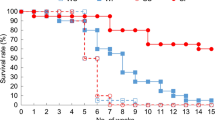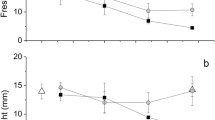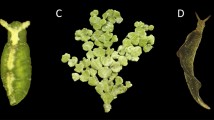Abstract
Sacoglossans use chloroplasts taken from algal food for photosynthesis (kleptoplasty), but the adaptive significance of this phenomenon remains unclear. Two con-generic sacoglossans (Elysia trisinuata and E. atroviridis) were collected in 2009–2011 from Shirahama (33.69°N, 135.34°E) and Mukaishima (34.37°N, 133.22°E), Japan, respectively. They were individually maintained for 16 days under four experimental conditions (combination of light/dark and with/without food), and their survival rate and relative (=final/initial) weights were measured. Both light and food had positive effects on the survival in E. trisinuata, whereas no positive effects of light or food on survival were detected in E. atroviridis. Both light and food had positive effects on relative weights in both species, but light had smaller effects than food. A significant interaction term between light and food was detected in E. trisinuata (but not in E. atroviridis) in that only the presence of both resulted in weight gains. This result suggests that E. trisinuata can obtain sufficient additional energy from photosynthesis for sustaining growth when fresh chloroplasts are continuously supplied from algal food. In addition, fluorescence yield measurements showed that unfed individuals of both E. trisinuata and E. atroviridis lost photosynthetic activity soon (<4 and 4–8 days, respectively). In conclusion, photosynthesis may function to obtain supplementary nutrition for sustaining growth when food is available in sacoglossans with short-term functional kleptoplasty.



Similar content being viewed by others
References
Agresti A (2002) Categorical data analysis, 2nd edn. Wiley, Hoboken, NJ
Barneah O, Brickner I, Hooge M, Weis VM, LaJeunesse TC, Benayahu Y (2007) Three party symbiosis: acoelomorph worms, corals and unicellular algal symbionts in Eilat (Red Sea). Mar Biol 151:1215–1223
Bhattacharya D, Pelletreau KN, Price DC, Sarver KE, Rumpho ME (2013) Genome analysis of Elysia chlorotica egg DNA provides no evidence for horizontal gene transfer into the germ line of this kleptoplastic mollusc. Mol Biol Evol 30:1843–1852
Christa G, Zimorski V, Woehle C, Tielens AG, Wägele H, Martin WF, Gould SB (2014) Plastid-bearing sea slugs fix CO2 in the light but do not require photosynthesis to survive. Proc R Soc B 281:20132493
Clark KB, DeFreese D (1987) Population ecology of Caribbean Ascoglossa (Mollusca: Opisthobranchia): a study of specialized algal herbivores. Am Malacol Bull 5:259–280
Clark KB, Busacca M, Stirts H (1979) Nutritional aspects of development of the ascoglossan, Elysia cauze. In: Stancyk SE (ed) Reproductive ecology of marine invertebrates. University of South Carolina Press, Columbia, SC, pp 11–24
Cobb AH (1978) Inorganic polyphosphate involved in the symbiosis between chloroplasts of alga Codium fragile and mollusc Elysia viridis. Nature 272:554–555
Dunlap MFS (1975) Symbiosis between algal chloroplasts and the mollusk Plakobranchus ocellatus van Hasselt (Sacoglossa: Opisthobranchia). Ph. D. Dissertation, University of Hawaii, Honolulu, Hawaii
Evertsen J, Johnsen G (2009) In vivo and in vitro differences in chloroplast functionality in the two north Atlantic sacoglossans (Gastropoda, Opisthobranchia) Placida dendritica and Elysia viridis. Mar Biol 156:847–859
Evertsen J, Burghardt I, Johnsen G, Wägele H (2007) Retention of functional chloroplasts in some sacoglossans from the Indo-Pacific and Mediterranean. Mar Biol 151:2159–2166
Gast RJ, Moran DM, Dennett MR, Caron DA (2007) Kleptoplasty in an Antarctic dinoflagellate: caught in evolutionary transition? Environ Microbiol 9:39–45
Giménez Casalduero F, Muniain C (2008) The role of kleptoplasts in the survival rates of Elysia timida (Risso, 1818): (Sacoglossa: Opisthobranchia) during periods of food shortage. J Exp Mar Biol Ecol 357:181–187
Greene RW (1970) Symbiosis in sacoglossan opisthobranchs: translocation of photosynthetic products from chloroplast to host tissue. Malacologia 10:357–368
Händeler K, Grymbowski PY, Krug P, Wägele H (2009) Functional chloroplasts in metazoan cells—a unique evolutionary strategy in animal life. Front Zool 6:1–18
Hinde R, Smith DC (1975) The role of photosynthesis in the nutrition of the mollusc Elysia viridis. Biol J Linn Soc 7:161–171
Ireland C, Scheuer PJ (1979) Photosynthetic marine mollusks: in vivo 14C incorporation into metabolites of the sacoglossan Placobranchus ocellatus. Science 205:922–923
Johnson MD, Oldach D, Delwiche CF, Stoecker DK (2007) Retention of transcriptionally active cryptophyte nuclei by the ciliate Myrionecta rubra. Nature 445:426–428
Kawaguti S, Yamasu T (1965) Electron microscopy on the symbiosis between an elysioid gastropod and chloroplasts of a green alga. Biol J Okayama Univ 11:57–65
Klochkova TA, Han JW, Kim J-H, Kim KY, Kim GH (2010) Feeding specificity and photosynthetic activity of Korean sacoglossan mollusks. Algae 25:217–227
Klumpp DW, Bayne BL, Hawkins AJS (1992) Nutrition of the giant clam Tridacna gigas (L.) I. Contribution of filter feeding and photosynthates to respiration and growth. J Exp Mar Biol Ecol 155:105–122
Maeda T, Kajita T, Maruyama T, Hirano Y (2010) Molecular phylogeny of the Sacoglossa, with a discussion of gain and loss of kleptoplasty in the evolution of the group. Biol Bull 219:17–26
Maeda T, Hirose E, Chikaraishi Y, Kawato M, Takishita K, Yoshida T, Verbruggen H, Tanaka J, Shimamura S, Takaki Y, Tsuchiya M, Iwai K, Maruyama T (2012) Algivore or phototroph? Plakobranchus ocellatus (Gastropoda) continuously acquires kleptoplasts and nutrition from multiple algal species in nature. PLoS ONE 7(7):e42024
Pelletreau KN, Bhattacharya D, Price DC, Worful JM, Moustafa A, Rumpho M (2011) Sea slug kleptoplasty and plastid maintenance in a metazoan. Plant Physiol 155:1561–1565
Pierce SK, Fang X, Schwartz JA, Jiang X, Zhao W, Curtis NE, Kocot KM, Yang B, Wang J (2012) Transcriptomic evidence for the expression of horizontally transferred algal nuclear genes in the photosynthetic sea slug, Elysia chlorotica. Mol Biol Evol 29:1545–1556
Rosenberg MS, Adams DC, Gurevitch J (2000) Meta win: statistical software for meta-analysis, version 2. Sinauer Associates, Massachusetts, MA
Rumpho ME, Worful JM, Lee J, Kannan K, Tyler MS, Bhattacharya D, Moustafa A, Manhart JR (2008) Horizontal gene transfer of the algal nuclear gene psbO to the photosynthetic sea slug Elysia chlorotica. Proc Natl Acad Sci USA 105:17867–17871
Schwartz JA, Curtis NE, Pierce SK (2010) Using algal transcriptome sequences to identify transferred genes in the sea slug, Elysia chlorotica. BMC Evol Biol 37:29–37
Takano T, Hirano YM, Trowbridge CD, Hirano YJ, Watano Y (2013) Taxonomic clarification in the genus Elysia (Gastropoda: Sacoglossa): E. atroviridis and E. setoensis. Am Malacol Bull 31:25–37
Trench RK, Green RW, Bystrom BG (1969) Chloroplasts as functional organelles in animal tissues. J Cell Biol 42:404–417
Trowbridge CD, Hirano YJ, Hirano YM (2008) Sacoglossan opisthobranchs associated with the green macroalgae Codium spp. on Pacific rocky shores of Japan. Venus 66:175–190
Tsuchida CB, Potts DC (1994) The effects of illumination, food and symbionts on growth of the sea anemone Anthopleura elegantissima (Brandt, 1835) I. Ramet growth. J Exp Mar Biol Ecol 183:227–242
Venn AA, Loram EJ, Douglas EA (2008) Photosynthetic symbioses in animals. J Exp Bot 59:1069–1080
Vieira S, Calado R, Coelho H, Serôdio J (2009) Effects of light exposure on the retention of kleptoplastic photosynthetic activity in the sacoglossan mollusc Elysia viridis. Mar Biol 156:1007–1020
Wägele H, Deusch O, Händeler K, Martin R, Schmitt V, Christa G, Pinzger B, Gould SB, Dagan T, Klussmann-Kolb A, Martin W (2011) Transcriptomic evidence that longevity of acquired plastids in the photosynthetic slugs Elysia timida and Plakobranchus ocellatus does not entail lateral transfer of algal nuclear genes. Mol Biol Evol 28:699–706
Yamamoto YY, Yusa Y, Yamamoto S, Hirano Y, Hirano Y, Motomura T, Tanemura T, Obokata J (2009) Identification of photosynthetic sacoglossans from Japan. Endocytobiosis Cell Res 19:112–119
Yamamoto S, Hirano YM, Hirano YJ, Trowbridge CD, Akimoto A, Sakai A, Yusa Y (2013) Effects of photosynthesis on the survival and weight retention of two kleptoplastic sacoglossan opisthobranchs. J Mar Biol Ass UK 93:209–215
Yoshie H, Yusa Y (2011) Indirect interactions in a rice ecosystem: density dependence and the interplay between consumptive and non-consumptive effects of predators. Freshw Biol 56:302–310
Acknowledgments
We thank Nobuo Yamaguchi and other staff at Mukaishima Marine Biological Laboratory and staff at Seto Marine Biological Laboratory for help, Keiji Wada, Cynthia D. Trowbridge, Judy Grassle, the anonymous reviewers, and our laboratory members for discussion and suggestions.
Author information
Authors and Affiliations
Corresponding author
Additional information
Communicated by J. P. Grassle.
Electronic supplementary material
Below is the link to the electronic supplementary material.
Rights and permissions
About this article
Cite this article
Akimoto, A., Hirano, Y.M., Sakai, A. et al. Relative importance and interactive effects of photosynthesis and food in two solar-powered sea slugs. Mar Biol 161, 1095–1102 (2014). https://doi.org/10.1007/s00227-014-2402-1
Received:
Accepted:
Published:
Issue Date:
DOI: https://doi.org/10.1007/s00227-014-2402-1




